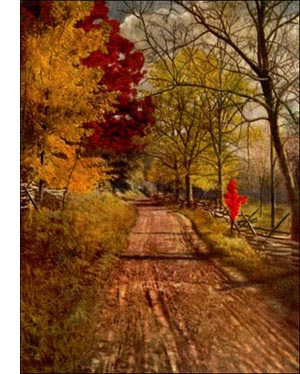Rowan Tree
 The Rowan Tree or European mountain ash (Sorbus Aucuparia, Linn.) is the one people usually plant on their lawns in this country. This trim, round-headed tree is very conventional and well-behaved compared with its country cousins back in the hills. Long discipline at the gardener's hands has made it what it is.
The Rowan Tree or European mountain ash (Sorbus Aucuparia, Linn.) is the one people usually plant on their lawns in this country. This trim, round-headed tree is very conventional and well-behaved compared with its country cousins back in the hills. Long discipline at the gardener's hands has made it what it is. In the craggy highlands of Scotland and Wales it leads a wild life, and is there quite different from the familiar garden tree. Strange legends and superstitions, centuries old, cluster around the rowan in all rural sections of Europe. They are preserved in the folklore and the literature of many languages. The tree, its berries, a leafy spray, or a bit of its wood-all were considered to be effectual charms to exorcise evil spirits, and to undo their work.
The rowan was planted at the gates of churchyards, and by cottage doors; and leafy twigs were hung over the thresholds. Crosses of "roan" wood, given out on festival days, were worn as amulets, and were tacked up over the doors of houses and barns. Milkmaids, especially, depended on them for the defeat of the "black elves" who tried to make their cows go dry, and, unless prevented, got into the churns, and then the butter would never come! We shall look upon this pretty tree with new interest, and perhaps a mild kind of awe, knowing how it has been regarded by our ancestors.
It may be known at any season by the woolly fuzz that whitens buds, twigs and the linings of leaves. The leaflets are small, dull green, with blunt points, and the margins have double teeth, large and small. The flowers and fruits are larger than those of our native species, and more showy.
Mountain ash berries at best are a poor, insipid sort of fruit. But as they hang on the trees very late, birds eat them with apparent satisfaction. During periods of deep snow, these trees are often the sole reliance of our hardy winter residents-the one bar between them and starvation.
The farther north a tree can grow, the more likely it is to have near relatives in the Old World. One mountain as} of Japan can be distinguished only with difficulty from our own; and some authorities consider our two species but varieties of the rowan tree of Europe, which extends its range well into Asia. Intermediate forms, growing wild with the two American species, show how each is apt to vary, and how very close is their relationship. All species are supposed to have sprung from a common ancestor not very long ago.